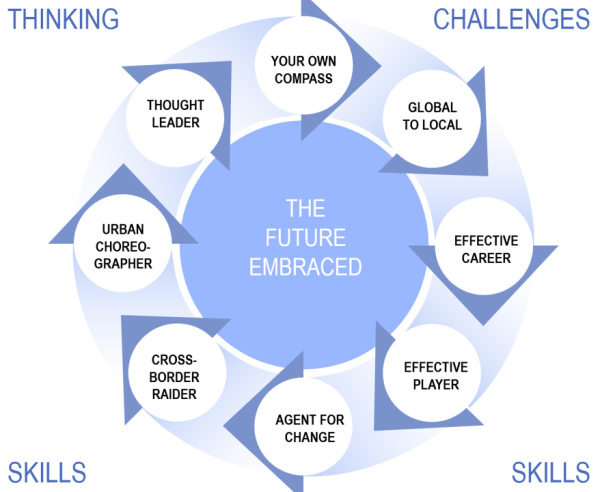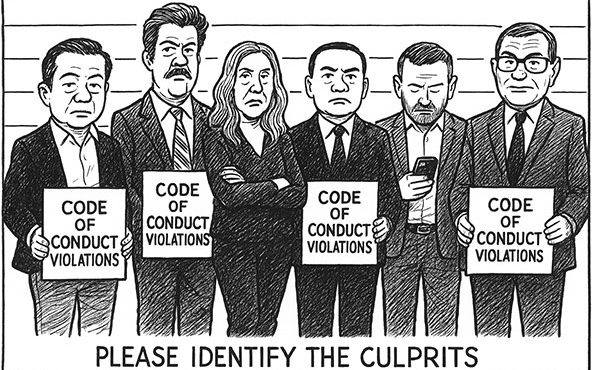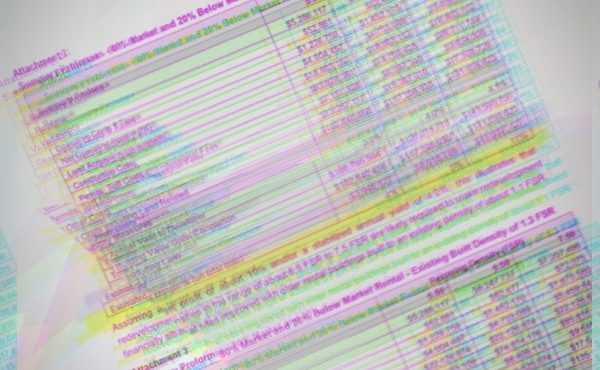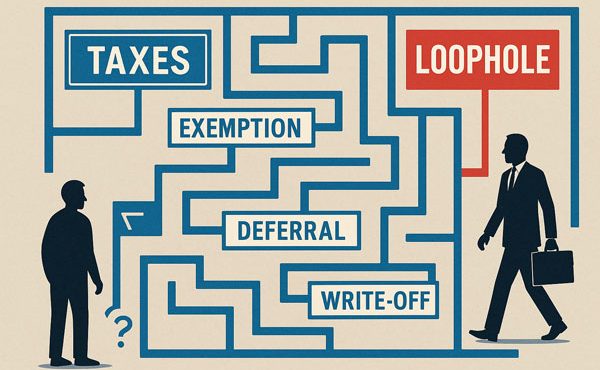
With so many challenges facing urban environments, it’s difficult for urban planning and design professionals to see where they might fit in and how to act, especially for those with a strong social or ecological conscience. Spacing Vancouver Editor-in-Chief Erick Villagomez had the opportunity to chat with Kobus Mentz—author of The Future Embraced: Career Insights for Professionals Who Care About The Planet and its People—to talk about his take on the skills professionals need in the face of an uncertain future.
EV: Thank you so much, Kobus, for taking the time to talk. I’m looking forward to this discussion. But before start, can you share a little information about yourself and background, for those who might not know who you are?
KM – I grew up in Zimbabwe, in the bush on a farm, where I developed an early awareness of nature and indigenous issues. As a young boy, my interest in architecture was also stimulated by watching my father build farm buildings and structures. Another influence was the nearby Driefontein Mission, which helped lift the local population out of poverty. They ran three hospitals, schools, workshops, a church, and a working farm, offering high-quality training in a wide range of technical and creative skills. When I later studied architecture, the idea that architecture should have a social purpose led me to focus on third-world development studies, including for my final year thesis.
My first job as an architect was to design non-governmental schools, creches, and community centers for the Urban Foundation in Johannesburg. They were a non-governmental organization that supported the poor and played a behind-the-scenes role in enabling Mandela’s release from prison. Then, in 1987, after a stint working in commercial architecture practices, as well as in my own firm, I received a scholarship to study at the Joint Centre for Urban Design—the JCUD—in Oxford.
EV – Clearly, social responsibility is a strong foundation for you and your work. Do you mind expanding on your time at the Joint Centre for Urban Design? It seems like an unusual decision to apply for the scholarship given that you had a practice to worry about. Was pursuing socially driven architecture the motivation behind this decision?
KM – The decision in 1987 to study further abroad was partly influenced by disillusionment with the political situation. Meaningful change, which came in 1994, was at that stage inconceivable.
It was also shaped by a growing awareness of the profound impact of the public realm on social life. That it is a political system that can either inspire, involve, and enrich, or demoralize, exclude, and impoverish. In developing countries, especially among the poor, this is glaringly obvious. Whereas, in the developed world, the relationship is more nuanced and complex. The JCUD affirmed my basic instincts and significantly enhanced them by instilling greater intellectual rigor and an improved ability to deliver practical, evidence-based outcomes.
EV – This is a perfect transition to your recently published book. All that you’ve talked about so far seems to be well-captured in the title: The Future Embraced: Career Insights for Professionals Who Care About The Planet and its People. It speaks to the social awareness and ethical responsibility that is the foundation of your life experiences. Can you tell us what motivated you to write the book?
KM – Over the years, I had increasingly heard from professionals—particularly younger ones—who felt overwhelmed by the complexity of our global challenges. They were perplexed at not knowing how to play a meaningful role in their resolution and unsure where they fit in.
Ashamed of my own incoherence on these questions I set off on a 13-year quest to form a response. This involved investigating the connections between individuals, our planet, how we may act on it, and which imperatives are critical to addressing our global challenges.
However, I soon realized that for a book on this topic to be effective it would need to operate at several levels. In addition to technical guidance, it would also need to touch on personal issues such as values, principles—even politics—as well as maintaining optimism and motivation. It would also have to reconcile having a successful career while making a difference. Without addressing these difficult reality trade-offs, it would risk just becoming another idealistic manifesto.
EV – And you interestingly structured the book under broad categories, accordingly—from “Future-relevant THINKING” to “Future-relevant CHALLENGES” and ending with “Future-relevant SKILLS”. Can you explain this further?
KM – The future-relevant part emphasizes the need to focus our efforts on the upcoming challenges as they are now becoming urgent. It is no longer an optional extra. The progression suggests, we first need the right thinking to select the right challenges and then the right skills to deliver on them. The book breaks down starting with “Thinking”. That is, ways of extending values into principles and how to engage with the myriad of sustainability approaches or movements that claim the moral high ground. It goes on to define four imperatives.
Next, it discusses “Challenges” or links to the global challenges we face with local opportunities. It then converts these issues into local initiatives using the imperatives outlined earlier in the book.
Finally, the book ends with discussing “Skills”—the attributes required to deliver the initiatives to these challenges. The skills range from; having effective foundational skills, driving change from within one’s own discipline, exerting influence by mastering other disciplines, choreographing complex outcomes, and developing thought leadership that delivers impactful change.
EV – This echoes the necessity of asking the right questions. Yet, given the urgency you mention, fewer people—municipal leaders and otherwise—are taking the necessary time to do this. Everyone seems to be making rushed decisions with little of the “future-relevance” you discuss. Naturally, this is the topic of the first chapter of the book and you offer some interesting food for thought. Although we can’t cover everything, I’d like to select some themes that resonated with me for you to comment on. First, that everyone is complicit.
KM – The section, Yet we are all complicit, claims that much of what we consume comes from somewhere else, and much of what we waste goes somewhere else. It then goes on to list an array of other instances of near-universal complicity in the causes of our global challenges.
The underlying point here is that to be judgemental is futile—it just drives the smug, who feel they are doing more than others, and the defensive, who feel guilty for doing less, further apart. With this humble acknowledgment, we are, hopefully, more likely to get over judging each other and get on with facing our challenges collectively.
Additionally, having acknowledged private complicity also puts a heightened emphasis on our obligation to act professionally—which gets to the core of the book.
EV – Indeed, it’s an important and necessary acknowledgment of an obligation to act ethically and professionally. This next topic you discuss I found quite interesting since it seems to be a common trap: Don’t let your Future be Shaped by Events Alone. Thoughts?
KM – While our futures are substantially—but not exclusively—shaped by events, we often underestimate the amount of agency we have over our futures. With the right application, we can better anticipate the future effects of fluctuations in local economies, policy shifts, the influx of competing skills, and disruptive technologies (automation, AI, etc). This will allow us to consider which skills or attributes we need to strengthen, or acquire, in order to respond to these changes and opportunities as they emerge. In some instances, it may suggest we create entirely new pathways or even move to a different context.
EV – To clarify, by “events” you mean things like changes in local economies, policies, technologies, etc.—and seeing these shifts as opportunities to get new skills as a means of responding, correct? And do you have examples of creating new pathways or contextual shifts? This seems to be an important idea.
KM – Correct. Although the shifts are usually threats which only become opportunities if you treat them as such. While changing context may involve changing jobs or location, creating new pathways involves engaging with the situation at hand. Some examples include professionals rapidly deepening their skill sets to fight back when their professional or financial status is being threatened….like when architects are usurped by professional project managers, urban planners having to play second-fiddle to transport planners, urban strategists being dictated to by Business Case specialists, and so on.
When threatened by a period of local economic austerity, I devised a new genre of methods, or pathways, that embraced the need to do more with less. Working with local authorities these ‘Blueprints’ speedily assessed their key policies and plans and agreed how they may be best re-prioritized. Then a handful of truly transformative initiatives were devised along with key community and private sector leaders. Ones which could be achieved at little cost to the authority.
These were then taken back to the public for endorsement. Various outcomes included: retaining wealth—which was previously lost to the community—new jobs, more affordable housing, and so on. Chapter 9 in the book offers more detail.
None of these projects were in the clients’ existing forward work plans or budgets, the idea had to be sold to them from scratch. Invented work like this helped sustain my practice during significant periods of economic downturn.
EV – Thanks for the clarification. I think this is a great foundation to build from as we dive deeper into the book. You outline four imperatives—Impact, Efficient, Balance, and Enriching—that are effectively the intellectual core of The Future Embraced. Along the way, you move through an interesting sequence from beliefs to values, to principles…ending in your imperatives. It would be great if you could elaborate on the sequence and resulting imperatives.
KM – Readers are urged to develop their own compass and to define the constants that inform their personal conduct—how they reason and what they stand for. Then they are asked to apply this to their professional world where there are more complex trade-offs to consider, for example to what degree excessive individual rights disadvantage the collective, or excessive collective rights restrict the individual. Or how too much power at the centre can diminish local democracy, while too much local power can frustrate national and regional objectives. Or when too much growth threatens environmental calamity, yet too little threatens economic collapse. Increasing wealth only improves social conditions up to a point.
They are also urged to consider how their values link with their politics, the inadequacies of left/right thinking, and which politicians prioritize our global challenges. However, even professionals at the grassroots level don’t seem to have a comprehensive approach that reflects our global urgency. To fill this vacuum the book proposes four imperatives to override other considerations.
The first is to deliver impactful change, thinking about the depth of transformation it delivers, the scale of change, or how systemic it is. The second, Efficiency, touches on how one occupies the earth’s surface, uses its resources, and minimizes consumption and waste. The third is Balance and how it balances legitimately competing needs, secures multiple benefits, and mitigates unavoidable impacts. The fourth is how it enriches people’s lives—how it inspires and supports cultural and spiritual needs.
The imperatives are in priority sequence and apply at several levels. They can serve as a guide for professionals’ everyday decision-making, criteria for project designs or selection, or even inform policymaking at the highest level of government.
EV – Now, after setting out these imperatives you describe the need to translate our global challenges to local issues that can be addressed at this level. Based on my experience, this is a challenge for many people as it requires a strong handle on scaling the seemingly insurmountable planetary problems we face and making them actionable at the individual level. What’s your take on the issue?
KM – Yes, individuals can quickly become overwhelmed if they feel they are shouldering all our global challenges on their own. It becomes more doable though when they focus on, and forensically map links relevant to their local situation and then plot a pragmatic pathway forward.
However, before delving into their professional specialisms they shouldn’t overlook generic truisms. For example, local energy-saving initiatives will reduce the harm created by energy imported from elsewhere. Measures to consume less imported goods locally will reduce global freight movements and relieve pressure on often vulnerable social and environmental conditions elsewhere. Strong local economic and health systems will not only help local communities survive the consequences of global health threats, but also help slow their spread around the world, as we have witnessed recently.
Professionals in their own fields can approach the issue top-down or bottom-up. Chapter 3 starts with a grand overview visualizing ‘twin peaks’ of people and planet-related global issues. It identifies 3 big issues groupings—poverty/quality of life, erosion of nature, and climate change which then cascades down to 18 topics that will help make cities and regions more compact, connected, competitive, human, and green.
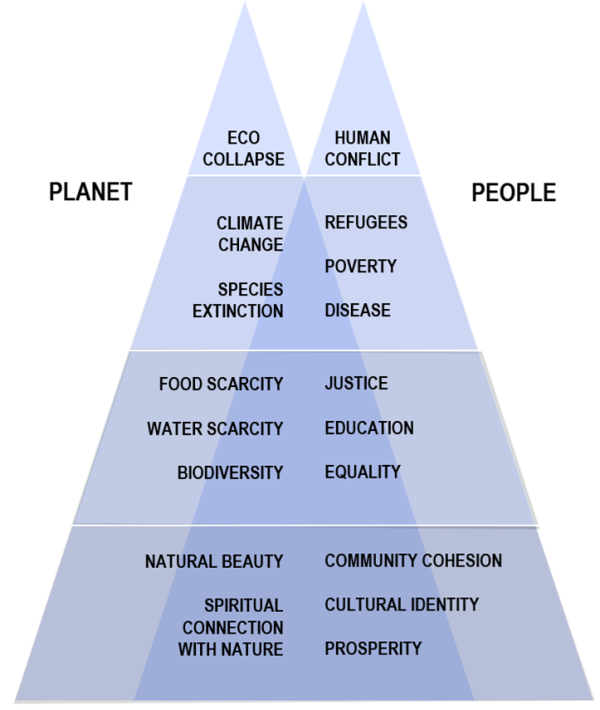
Some readers may wish to skip the intellectual framework and go directly to those topics relevant to them. These cover issues such as poverty, energy, prosperity, creativity, the public realm, biodiversity waste and so on.
The list is not conclusive, and the reader may identify other pertinent topics. Each topic (worthy of a PhD) is covered on only a page or two. The narrative throughout aims to instill a way of thinking about them, to distill their essence, and how to identify local opportunities by applying the imperatives formulated earlier on.
The global to local links theme re-surfaces in different formats further on. For instance, Shape Your Career—chapter 4—explores different career pathways which deliver change, and how they involve available local opportunities. Similarly, Be an Agent for Change—chapter 6—offers an Ethics Decision Tree which guides the user through the ethical legitimacy and global relevance of different local initiatives.
Readers should be encouraged that there are many pathways to establishing local opportunities that link with global challenges. With some applications, they are bound to figure out their own route.
EV – This is a perfect segue into the Skills chapters of the book. Based on what you just said, can you take us through the progression of skills as you see it? You can focus on the ones you feel are most relevant and important.
KM – Sure. The Shape Your Career chapter first considers the context of one’s career, the sacrifices required to build a legacy and develop impactful professional cultures, as well as where to position yourself on the innovation-to-production continuum.
While these may suggest some specific skills-needs for each individual professional, I suggest that for them to be future-relevant, it will help if they progressively move from good foundation skills to driving change from within their own discipline, exerting influence by mastering other disciplines, choreographing complex outcomes, and developing thought leadership that delivers impactful change.
Within the Be an Effective Player chapter, I suggest that, despite being crucial during periods of change, having good foundational skills is frequently overlooked. These can help one stay motivated and balance immediate commitments with long-term goals. They can enhance one’s ability to understand (observe, listen, search) with intent and communicate persuasively by wrapping your ideas up in good grammar and learning how to weaponize humour.
One’s visual literacy and design abilities can also be strengthened, especially when learning how to employ logical and creative thinking concurrently.
EV – Now, these skills are general enough to be applicable across the board, correct? That is, across one’s entire career.
KM – That’s right…and I believe certain skills are more important at different times over one’s career. So, for those at a mid-career level, I think it’s important to know how to master the core science and principles of one’s profession. This will enable innovative outcomes that, if on the right side of the ledger, will well exceed business-as-usual practices. I call this being an agent for change.
This leads to being “a Cross-border Raider”. Meaning that one wants to know how to breach professional boundaries and when to apply solution-centred approaches or issue-centred ones. Complex outcomes invariably require multi-disciplinary approaches, so the ability to drive change will depend on the ability to influence other disciplines.
EV – I find being versed in different disciplines so important to contemporary practice, given the complexity of the issues we face globally. But it takes a lot of time to build this up. Arguably we are now moving out of the mid-career level.
KM – Yes, it does take a while and does transition to the final two skills which I consider to be at the mature professional level. The first is to be an “Urban Choreographer”—that is, learning how to structure complex processes to foster cultures of enthusiasm, collaboration, and creativity. One wants to know which settings to get right before moving from exploration to resolution. The chapter offers insights on how to target the issues that matter most, generate great ideas that work, and convert complex strategies into actionable outcomes.
The final skill in my sequence is being a “Thought Leader”. I want to urge people to think about thinking—metacognition—and distinguish between borrowed thinking, context-moderated thinking, experience-moderated thinking, and new thinking.
I believe that thought leaders apply thinking that is compelling enough to influence the thinking and actions of others. It makes them see the world differently. With this in mind, I offer a selection of approaches including how to influence the influencers, make better rules, inspire good governance, lead through exemplar projects, and crystallize large-scale complexity.
EV – Thank you so much, Kobus, for that comprehensive rundown. You’ve left us with a lot of food for thought. Your perspective and suggestions are much needed during this time of so many global and local challenges. I really appreciate the time you’ve taken to chat with us. Is there anything else you would like to share as parting thoughts?
KM – As the book covers different levels of professional maturity, it is a long read in a world of quick fixes. Instead of single-use solutions, it offers a framework of thinking with insights that can be adapted, adjusted, or reinvented by the reader. At its core is an optimism that we all have some agency to make a difference and that if we embrace the future, we can collectively have a bearing on our destiny.
*****
Kobus Mentz is based in Auckland, New Zealand. He has practiced as an architect and urban designer there and in Africa, the UK, and Australia producing internationally recognized growth strategies, urban regeneration plans, and influential demonstration projects. He has also delivered urban design training for over 1,000 mid-career professionals, published widely, and taught at numerous universities, latterly as an adjunct professor. He recently published a book called The Future Embraced.
Erick Villagomez is the Editor-in-Chief at Spacing Vancouver and teaches at UBC’s School of Community and Regional Planning. He is also the author of The Laws of Settlements: 54 Laws Underlying Settlements Across Scale and Culture.
***
Other Spacing Vancouver and Spacing interviews:
- Downtown in Transition: An Interview with Sean Bailey
- Embracing the Future: An Interview with Kobus Mentz
- Inequality, Gender, Intersectionality, Gentrification, and the City: An interview with Leslie Kern
- Talking Landscape Architecture: An Interview with Marc Treib
- Architecture and Capital in the 21st Century: An Interview with Matthew Soules
- On Interior Urbanism: An Interview with Jeremy Senko
- From Chief Planner to “Urban Ronin”? Chatting about legacy, and the future, with Brent Toderian – Part 1
- From Chief Planner to “Urban Ronin”? Chatting about legacy, and the future, with Brent Toderian – Part 2
- Optimizing Social Connection: An Interview with Saif Khan
- On This Patch of Grass: An Interview with Matt Hern, Daisy Couture, Selena Couture, and Sadie Couture
- THE ARTFUL CITY: An Interview with Sean Martindale
- Vaudeville Vancouver: An Interview with Tom Carter
- Women in Design: An interview with Johanna Hurme of 5468796 Architecture
Living History: An Interview with Eve Lazarus - Where Happiness and Urban Design Intersect
- 2012 InReview: Gregor Robertson Interview
- Malcolm Bromley & Constance Barnes Interview – Part 1
- Malcolm Bromley & Constance Barnes Interview – Part 2
- Malcolm Bromley & Constance Barnes Interview – Part 3
- Malcolm Bromley & Constance Barnes Interview – Part 4
- From Chief Planner to “Urban Ronin”? Chatting about legacy, and the future, with Brent Toderian – Part 1
- From Chief Planner to “Urban Ronin”? Chatting about legacy, and the future, with Brent Toderian – Part 2

